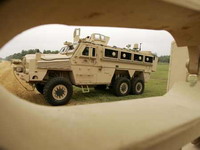Marine Corps to buy new bomb-resistant vehicles
Marine Corps will buy a third fewer bomb-resistant vehicles to protect U.S. forces in Iraq and Afghanistan from deadly roadside bombs.

Outwardly, the cut by the Marines is a mere dent in the more than $20 billion (13.5 billion EUR) program for mine-resistant, ambush-protected vehicles known as MRAPs. Yet the reasons behind the move - reduced violence in Iraq and the ponderous weight of the vehicle - may signal further overall reductions.
"I don't think it's the beginning of the end," said Dakota Wood, a senior fellow at the Center for Strategic and Budgetary Assessments and co-author of a study on the vehicles. "But if the improved security situation in Iraq continues, then they don't need as many of these MRAPs as they thought they did."
Counting the 2,300 the Marines now plan to acquire plus those for other military branches, the Pentagon still is on track to purchase close to 14,000 of the trucks, which weigh between 19 and 40 tons and feature a blast-deflecting V-shaped hull.
In Congress and among the handful of companies now building the MRAPs, talk of lower numbers is a sensitive subject. Each manufacturer has made a healthy investment in personnel, material and facilities in a furious rush to deliver vehicles to the troops. And Democrats and Republicans, in a rare display of bipartisanship, have provided $21 billion (14.2 billion EUR) to pay for what Defense Secretary Robert Gates has labeled the Pentagon's top acquisition priority.
"This isn't a jobs program," Rep. Gene Taylor, a Democrat, said at a recent House Armed Services Committee hearing where lawmakers criticized the Pentagon for moving too slowly to get the vehicles into the war zone. "This is a rescue mission."
More than 8,800 MRAPs have been ordered by the Defense Department so far. About 1,800 have been delivered and more than 700 have been shipped to troops in Iraq and Afghanistan. The Pentagon says 1,500 MRAPs will be in combat zones by the end of the year.
Almost 1,700 U.S. troops have been killed by improvised explosive devices in Iraq since July 2003, according to the Web site iCasualities.org., out of a total of at least 3,880 members of the U.S. military who have died since the beginning of the Iraq war in March 2003.
Buying a third fewer MRAPs is expected to save the Marines $1.7 billion (1.1 billion EUR). The cut did not come as a surprise to those who follow the program closely. Gen. James Conway, the Marine Corps commandant, said in October he did not know what the Marines would do with the vehicles once the roadside bomb threat subsided. The Marine Corps is a light, rapid-reaction force and would be bogged down by the massive MRAPs.
Conway said Friday the Marine Corps would get 1,400 fewer MRAPs than previously planned. He said improvised explosive device attacks are down sharply in western Iraq where most of the Marines operate. He also cited the inability to use the massive MRAPs for chasing terrorists in urban areas, off main roads, and over less stable bridges.
For those reasons, the Marines need more armored Humvees, which are lighter and more mobile, Conway said.
Ultimately, the Marines want to replace the Humvee with a new system called the Joint Light Tactical Vehicle. The push to buy the MRAPs, however, is siphoning money away from that project.
Executives at Force Protection, Inc.said the Marine cut will have little effect on their growing business, although defense industry analysts say the company located has the most to lose. The Marine Corps has been Force Protection's largest customer.
"This simply enables us to service other customers who are standing in line for our vehicles," said Michael Aldrich, Force Protection's vice president for business development.
The Army plans to acquire 10,000 MRAPs. The Navy, Air Force and Special Operations Command are also buying the vehicles, although in much smaller numbers.
Subscribe to Pravda.Ru Telegram channel, Facebook, RSS!




